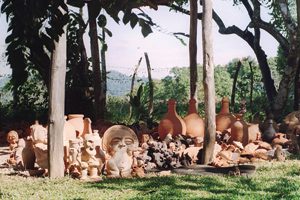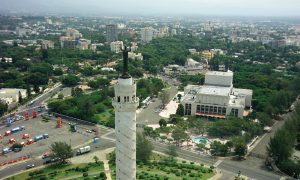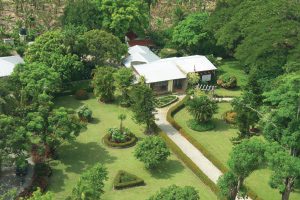
Other Destinations
The Dominican Republic has much more than beautiful beaches and stunning mountains; throughout the Dominican territory, in every corners of the country, many attractions and wonders are discovered by those who visit and inhabit this Caribbean paradise. The natural, cultural and historical wealth of the country is found in all the coordinates.
 Monte Plata
Monte Plata
Universally known as the emerald province, Monte Plata amazes with its great ecotourism potential, as well as business and cruise tourism. Natural thermal pools, agro-tourism, cultural experiences and manifestations of the community’s religious devotion, are just some examples of the activities that are recommended for this area. The Monte Plata Tourism Cluster offers more details here: http://turismomonteplata.com.do
Did you know? The Guillén Brothers live in Yamasá, a province of Monte Plata. They are dedicated to the production of Taíno and Neotaí pottery objects made of clay and other materials, the objects of the Taíno religious and cultural observances, based on the pictorial findings and the disinterment of original settlements. It is an essential part of a visit and an incredible experience. http://www.artesaniaguillen.com
Espaillat
The Espaillat province, in the northern region of the country, offers such a historical, cultural and environmental diversity that it makes it a complement for lovers of mountain, beach and eco-friendly tourism. The following festivities are highlighted: the Assumption of Mary, the Municipal Festival Day, the Carnival, ecotourism routes to Las Caobas/Arroyo Frío and El Ramonal/Las Espinas, kayak routes, the Charcos de Arroyo Frío, the Tinajones ecological route, and the cultural and the artisans of Moca route. The Rogelio Beach, located in the Community of Magante, is another of its main attractions. It has a fish Boulevard with “a sustainable gastronomic offer that takes full advantage of the typical products of the area and guarantees a unique gastronomic experience of its kind in the area.” The Ecotourism Cluster of Espaillat offers more abundant details of the offer of this beautiful destination: http://www.proespaillat.com
Did you know? Mofongo is a distinctive dish and a reference in Espaillat. Its original version is made with bananas, garlic, and pork rinds. In addition, the area sweets are a hallmark, and the Mocana cookies have made the region popular within the country. They have also become a nostalgic product for Dominicans abroad.
 Santiago
Santiago
Santiago de los Caballeros, or Ciudad Corazón, is the second largest city of the Dominican Republic. In addition to its booming economy, and being home to major industries and businesses, Santiago has become a growing tourist destination, positioning itself for its cultural, historical, and gastronomic wealth, as well as for its attributes as a cosmopolitan city in the center of the country.
A walk through the city center reveals its aristocratic architecture, which complements other impressive cultural legacies: the Monument to the Heroes of the Restoration, one of the province’s main tourist and leisure attractions and where countless cultural artistic and musical events are celebrated; as well as the Apostle Santiago Cathedral and Plaza de la Cultura. The typical “horse-drawn carriage ride” through the center of the city, in addition to the visit to a cigar factory (starting with a view of the beautiful tobacco fields), complete Santiago’s offer.
Did you know? Centro León is a must when you are in Santiago; it is an active cultural space that offers a spectacular tour of its collections of visual and anthropological arts, which cover the fundamental components of the Dominican culture and habitat, from the time when the island was populated by indigenous people. http://centroleon.org.do
Dajabón
Dajabón is one of the provinces of the Dominican Republic that borders the Republic of Haiti. It provides an excellent view of the Cordillera Central and numerous other natural attractions, including a forest paradise (there is a significant number of pine trees). Loma de Cabrera (also known as the Cradle of the Restoration), is where el grito de Capotillo took place in 1863, thus giving rise to the restoration effort in which Dominicans and Haitians joined forces to overthrow Spain.
Did you know? The main Binational Market in the country operates in Dajabón, a place where commercial exchange between the Dominican Republic and Haiti is promoted. This market, which started at the time of the colony, takes place in Dajabón, the capital of the municipality of the province of the same name, and it is held every Monday and Friday. It is said that more than 3,000 merchants from both countries offer their products in this market to more than 30,000 customers.
The historical-cultural resources of the province offer a range of opportunities for those who visit the area. Among the most important are: El Arco, the Monument to the Heroes of The Battle of Beller, the Binational Market and the Dajabón Carnival. The religious festivities of its different municipalities are also important tourist attractions for the province, where the Nuestra Señora de la Altagracia in Loma de Cabrera, the Nuestra Señora del Rosario in Dajabón, and the Santa Rosa de Lima in the Partido municipality stand out.
Dajabón has a Tourist Cluster that offers a wide variety of information about the destination, as well as on the gastronomic, cultural, historical and hotel offer of the area. http://www.godajabon.com/cluster-turistico/
San Cristóbal, Peravia, and Azua
These three provinces are located in south of the Dominican Republic.
San Cristóbal offers its visitors Balneario La Toma, and breezy mountains where small restaurants allow you to enjoy tropical delights in the midst of an impressive natural landscape.
One of the most important attractions in Peravia is the Cuevas de Pomier or Borbón complex, the richest place with cave painting in the Antilles. The complex includes 51 caverns and six pictographs and petroglyphs.
Colorful wooden houses welcome visitors to its industrious environment in Baní, the main city of the Peravia province. The Salinas beach of Puerto Hermoso welcomes beachgoers who want to fully enjoy the Caribbean Sea, and be amazed with the impressive landscape of the salt mines that are the result of the evaporation of seawater.
Did you know? The Dunas de Baní are a desert in the Caribbean. They are located in the Las Calderas peninsula, between the towns of Matanzas, Las Calderas and Las Salinas, and extend for dozens of kilometers of fine sand, rich in quartz and feldspar. Visiting Las Dunas de Baní is an extremely interesting experience.
Did you know? The Perelló family, native of Baní, has been linked to coffee production since the nineteenth century and developed its coffee companies during the second half of the twentieth century. The Perelló companies produce a brand of international prestige in the world of coffee, which has been characterized by a tradition of high quality standard. For many decades, Baní has symbolized the business and work cultures, which are key to the business success of the people from Baní in different places, circumstances and at different scales, from the villages closer to the city to the towns and cities of the United States and other places of the world. Visit the Perelló Cultural Center in Baní: http://www.ccp.org.do
Los Corbanitos, with an extension of approximately nine kilometers of virgin beaches of singular beauty and impressive dunes of white sand, are part of the attraction of the area. Bahía de Caldera is located in the extreme southwest of the province of Peravia, another place of interest because of the important naval base of the Dominican War Navy, protected by nature itself, due to the closed conformation of the bay’s geography.
Among other tourist attractions, Azua features the ruins of the first city, founded in 1504, and a town that is a unique example of vernacular architecture on the island, with centuries-old wooden houses. Its beaches of gray sand and deep waters, with a rich marine fauna make them ideal for troll fishing, especially in the Palmar de Ocoa Bay, where the spectacular nature of its sunsets stands out.
La Zurza, a natural spa of sulphurous waters, located in the community of Las Yayas, competes among adventure lovers with the hot springs of Sierra de Martín García, the thermal pools of Ríos Grande, las Cuevas, and the José del Carmen Ramírez and the Sierra Martín García National Parks, among others.
Santiago Rodríguez y Valverde
Nalga de Maco, Armando Bermúdez, and José del Carmen Ramírez National Parks, the natural thermal pools of the Guayubín and Mao rivers, the casabe-making workshops, craft workshops and beautiful mountains are among the main attractions of the Santiago Rodríguez Province, in the northwest of the country.
To learn more about the Armando Bermúdez National Park, please visit: http://www.ambiente.gob.do/ambienterd/eco-parque/parque-nacional-armando-bermudez/
Did you know? Casabe is a dry, thin and circular bread that is made after a long and labor intensive process of gratin, pressing, and drying cassava to extract the juice, and then grinding it to obtain a fine flour, from which casabe is made. Dominicans use casabe very often in their cuisine. More information about this and other typical products can be found in the publication Lo Dominicano | All Things Dominican, which can be purchased here.
The Valverde Province, founded in the early seventeenth century, is called “The city of the beautiful sunsets” by locals and visitors. Its main tourist attractions are the famous Ruta de Colón or Paso de Los Hidalgos, as well as mountains with superb landscapes, its handicrafts, the natural thermal pools of the Mao and Amina rivers, its indigenous cemeteries and Victorian architecture.
 Hermanas Mirabal
Hermanas Mirabal
Formerly known as Salcedo, the Hermanas Mirabal Province offers visitors the interesting story of the three Mirabal sisters. The remains of these brave women rest in Ojo de Agua, in the outskirts of the city of Salcedo. Casa Museo de Las Hermanas Mirabal, the Monument to the Mirabal Sisters, and the Casa de Patria Memorial Garden are also located there. Buried in the same place are the remains of Manuel Aurelio Tavárez Justo, who was president of Movimiento 14 de Junio and the husband of Minerva Mirabal.
In November, 2007, the Salcedo Province, cradle of the Butterflies (as Patria, Minerva and María Teresa Mirabal are known), officially became the Hermanas Mirabal Province in their honor.
Did you know? Since November 25, 1999, the United Nations commemorates the International Day for the Elimination of Violence Against Women in honor of the Mirabal Sisters.
Did you know? American writer of Dominican descent Julia Álvarez wrote in 1994 a successful novel based on the Mirabal sisters, called “En el tiempo de las mariposas” (In the time of butterflies). The book was then turned into a film in 2001, produced by M.G.M. and Showtime and under the direction of Mariano Barroso, with performances by Salma Hayek, Marc Anthony, Edward J. Olmos and Mia Maestro.
Did you know? Dedé, the last survivor of Las Mirabal sisters, wrote her first and only book entitled “Vivas en su jardín” (Alive in their garden), published on August 25th, 2009. One of her sons, Jaime David Fernández Mirabal, served as vice president of the Dominican Republic during the first period of government of Leonel Fernández (1996-2000). Minou Tavárez Mirabal, daughter of Minerva, has also been involved in political activities, when she ran for President of the Republic. Dedé passed away on February 1st, 2014 due to lung complications.
More information about the Province: http://www.provinciahermanasmirabal.gob.do
Casa Museo Hermanas Mirabal: http://casamuseohermanasmirabal.com
María Trinidad Sánchez
From Samaná you can travel to the cities of Nagua and Cabrera in the Province of María Trinidad Sánchez, located in the Eastern Cibao Region, about 126 kilometers from the Dominican capital. The seashore of Nagua has great beaches, which beachgoers from all over the country enjoy throughout the year. Cabrera, la Escocesa Bay, hosts beaches of shallow waters and gentle waves that make it an ideal place for scuba diving. An important tourist attraction is the Gran Laguna National Park, where mangrove forests abound.


